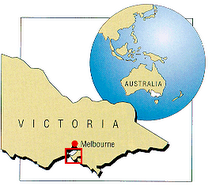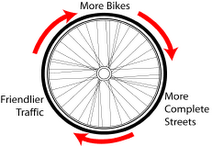New VicRoads rules for cyclists
|
VicRoad changes include new rules relating to helmet and seat use for bicycle passengers and rules for cyclists turning from, and stopping in, bicycle boxes at signalised intersections.
IMPORTANT ROAD LAW UPDATE - PLEASE NOTE: The road rules for cyclists are changing in Victoria.
From 9 November 2009, there will be new rules for cyclists in Victoria.
The changes include new rules relating to helmet and seat use for bicycle passengers and rules for cyclists turning from, and stopping in, bicycle boxes at signalised intersections.
More than 1,000 cyclists are injured in crashes with motor vehicles each year.
These new rules will help improve their safety when riding with traffic.
If both cyclists and their passengers wear helmets, the risk of head injury is reduced in a crash.
Bicycle boxes allow cyclists to wait ahead of traffic at signalised intersections so drivers can see them more easily.
The new road safety rules will come into effect on 9 November 2009 and it’s up to every road user to know them, before they leave home.
THE CHANGES:
Seat and helmet
A bicycle passenger must wear an approved bicycle helmet and sit on a proper seat when riding on a bicycle.
Area reserved for cyclists (bicycle box)
A driver must stop at the first line of the bicycle box while a cyclist must stop at the second line, within the bicycle box. See diagram right.
Turning at intersections
When turning at intersections with a bicycle box a bicycle rider:
- if turning left, must be in the left lane of the reserved area
- if turning right, must be in the right lane of the reserved area (where there is a bicycle box in the right lane). If no reserved area is present a standard right hand turn can be performed by signaling and turning from the right hand turn lane. Alternately a rider may perform a hook turn from the left lane.
What you have to do
If you are a bicycle passenger, make sure you are wearing an approved bicycle helmet and sitting on a proper seat.
If you are using the bicycle box ensure you keep clear of the pedestrian area.
What else can cyclists do to increase safety?
- use lights at night at both the front and rear of the bicycle
Road safety reasons
Cyclists and their passengers are some of the most vulnerable road users. More than 1,000 cyclists are injured in crashes with motor vehicles each year. These new rules aim to improve their safety when riding with traffic.
If both cyclists and their passengers wear helmets, the risk of head injury is reduced in a crash.
Using a proper seat keeps the bicycle more stable and lessens the risk of crashing.
Bicycle boxes allow cyclists to wait ahead of traffic at signalised intersections and to get a head start on motor vehicles. This way cyclists can be more easily seen by drivers.
Click here to view the VicRoads Frequently Asked Questions.
For more information visit the VicRoads website at www.vicroads.vic.gov.au/roadrules or call 1300 360 745












